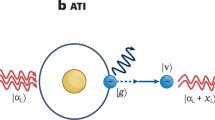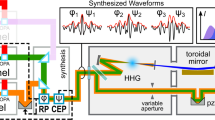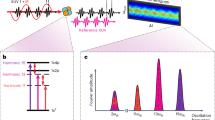Abstract
Attosecond extreme-ultraviolet pulses1 have a complex space–time structure2. However, at present, there is no method to observe this intricate detail; all measurements of the duration of attosecond pulses are, to some extent, spatially averaged1,3,4,5. A technique for determining the full space–time structure would enable a detailed study of the highly nonlinear processes that generate these pulses as a function of intensity without averaging6,7. Here, we introduce and demonstrate an all-optical method to measure the space–time characteristics of an isolated attosecond pulse. Our measurements show that intensity-dependent phase and quantum-path interference both play a key role in determining the pulse structure. In the generating medium, the attosecond pulse is strongly modulated in space and time. Propagation modifies but does not erase this modulation. Quantum-path interference of the single-atom response, previously obscured by spatial and temporal averaging, may enable measuring the laser-field-driven ion dynamics with sub-cycle resolution.
This is a preview of subscription content, access via your institution
Access options
Subscribe to this journal
Receive 12 print issues and online access
$259.00 per year
only $21.58 per issue
Buy this article
- Purchase on SpringerLink
- Instant access to full article PDF
Prices may be subject to local taxes which are calculated during checkout



Similar content being viewed by others
References
Paul, P. M. et al. Observation of a train of attosecond pulses from high harmonic generation. Science 292, 1689–1692 (2001).
Salières, P. et al. Feynman’s path-integral approach for intense-laser-atom interactions. Science 292, 902–905 (2001).
Sansone, G. et al. Isolated single-cycle attosecond pulses. Science 314, 443–446 (2006).
Kim, K. T. et al. Self-compression of attosecond high-order harmonic pulses. Phys. Rev. Lett. 99, 223904 (2007).
Goulielmakis, E. et al. Single-cycle nonlinear optics. Science 320, 1614–1617 (2008).
Zair, A. et al. Quantum path interferences in high-order harmonic generation. Phys. Rev. Lett. 100, 143902 (2008).
Smirnova, O. et al. High harmonic interferometry of multi-electron dynamics in molecules. Nature 460, 972–977 (2009).
Quéré, F., Itatani, J., Yudin, G. L. & Corkum, P. B. Attosecond spectral shearing interferometry. Phys. Rev. Lett. 90, 073902 (2003).
Mairesse, Y. & Quéré, F. Frequency-resolved optical gating for complete reconstruction of attosecond bursts. Phys. Rev. A 71, 011401 (2005).
Lee, D. G., Park, J. J., Sung, J. H. & Nam, C. H. Wave-front phase measurements of high-order harmonic beams by use of point-diffraction interferometry. Opt. Lett. 28, 480–482 (2003).
Frumker, E., Paulus, G. G., Niikura, H., Villeneuve, D. M. & Corkum, P. B. Frequency-resolved high-harmonic wavefront characterization. Opt. Lett. 34, 3026–3028 (2009).
Austin, D. R. et al. Lateral shearing interferometry of high-harmonic wavefronts. Opt. Lett. 36, 1746–1748 (2011).
Chini, M., Gilbertson, S., Khan, S. D. & Chang, Z. Characterizing ultrabroadband attosecond lasers. Opt. Express 18, 13006–13016 (2010).
Dudovich, N. et al. Measuring and controlling the birth of attosecond XUV pulses. Nature Phys. 2, 781–786 (2006).
Doumy, G. et al. Attosecond synchronization of high-order harmonics from midinfrared drivers. Phys. Rev. Lett. 102, 093002 (2009).
Dahlström, J. et al. Atomic and macroscopic measurements of attosecond pulse trains. Phys. Rev. A 80, 033836 (2009).
Bertrand, J. B. et al. Ultrahigh-order wave mixing in noncollinear high harmonic generation. Phys. Rev. Lett. 106, 023001 (2011).
Brugnera, L. et al. Trajectory selection in high harmonic generation by controlling the phase between orthogonal two-color fields. Phys. Rev. Lett. 107, 153902 (2011).
Corkum, P. B. Plasma perspective on strong field multiphoton ionization. Phys. Rev. Lett. 71, 1994–1997 (1993).
Lewenstein, M., Salières, P. & Ľ’Huillier, A. Phase of the atomic polarization in high-order harmonic generation. Phys. Rev. A 52, 4747–4754 (1995).
Kane, D. J. & Trebino, R. Characterization of arbitrary femtosecond pulses using frequency-resolved optical gating. IEEE Quant. Electron. 29, 571–579 (1993).
Kane, D. J. Recent progress toward real-time measurement of ultrashort laser pulses. IEEE Quant. Electron. 35, 421–431 (1999).
Trebino, R. Measuring the seemingly immeasurable. Nature Photon. 5, 189–192 (2011).
Mairesse, Y. et al. Attosecond synchronization of high-harmonic soft x-rays. Science 302, 1540–1543 (2003).
Smirnova, O. et al. Attosecond circular dichroism spectroscopy of polyatomic molecules. Phys. Rev. Lett. 102, 063601 (2009).
Kienberger, R. et al. Atomic transient recorder. Nature 427, 817–821 (2004).
Zair, A. et al. Molecular internal dynamics studied by quantum path interferences in high order harmonic generation. Preprint at http://arxiv.org/abs/1210.4814v1 (2012).
Goulielmakis, E. et al. Real-time observation of valence electron motion. Nature 466, 739–743 (2010).
Shiner, A. D. et al. Wavelength scaling of high harmonic generation efficiency. Phys. Rev. Lett. 103, 073902 (2009).
Acknowledgements
We gratefully acknowledge the technical assistance of D. Crane and B. Avery. We also acknowledge financial support from NSERC, AFOSR and MURI Grant No. W911NF-07-1-0475. In addition, E.F. acknowledges support from the Marie Curie International Outgoing fellowship.
Author information
Authors and Affiliations
Contributions
K.T.K. and P.B.C. conceived the idea and designed the experiment. K.T.K., C.Z., A.D.S., S.E.K. and G.G. performed the experiment and collected the data. K.T.K. provided the theoretical analysis and analysed the experimental data. K.T.K., D.M.V. and P.B.C. prepared the initial manuscript. All authors contributed in writing the manuscript.
Corresponding author
Ethics declarations
Competing interests
The authors declare no competing financial interests.
Supplementary information
Supplementary Information
Supplementary Information (PDF 816 kb)
Rights and permissions
About this article
Cite this article
Kim, K., Zhang, C., Shiner, A. et al. Manipulation of quantum paths for space–time characterization of attosecond pulses. Nature Phys 9, 159–163 (2013). https://doi.org/10.1038/nphys2525
Received:
Accepted:
Published:
Issue date:
DOI: https://doi.org/10.1038/nphys2525
This article is cited by
-
Attosecond field emission
Nature (2023)
-
Attosecond streaking of sub-cycle electron wave packets for probing rescattering dynamics in an intense laser field
Journal of the Korean Physical Society (2023)
-
Spatio-temporal characterization of attosecond pulses from plasma mirrors
Nature Physics (2021)
-
Attosecond streaking using a rescattered electron in an intense laser field
Scientific Reports (2020)
-
Double-blind holography of attosecond pulses
Nature Photonics (2019)



